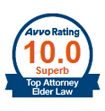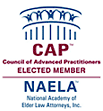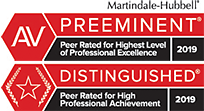Emerging Medicaid Eligibility Strategies
Emerging Medicaid Eligibility Strategies
By Donald D. Vanarelli, Esq.
In recent months, we have seen a number of administrative law decisions and cases that address various Medicaid planning issues. These new decisions provide valuable insight into the current feasibility of planning strategies in this evolving area of practice.
Practitioner’s Tip #1: Consider the Purchase of an Annuity for the Community Spouse
For Medicaid purposes, the purchase of an annuity that is irrevocable, nonassignable, actuarially sound, and provides for payments in equal amounts, with no deferral and no balloon payments, is not a transfer for less than fair market value. 42 U.S.C. §1396p(c)(1)(G)(ii). Assuming that an annuity meets the foregoing requirements, and satisfies the funding and beneficiary designation requirements of the DRA, elder law practitioners should consider the purchase of an annuity for a community spouse as a Medicaid planning tool.
The use of annuities as a Medicaid planning technique received substantial support from the third circuit in James v. Richman, 547 F.3d 214 (3d Cir. 2008). The James court held that an annuity purchased by a community spouse was not an available “resource,” because the owner of the annuity did not have the power to change ownership. With regard to the income stream of the annuity, because “no income of the community spouse shall be deemed available to the institutionalized spouse,” 42 U.S.C. §1396r-5(b)(1), the sale of the income stream cannot be compelled. Id.
Although the James case involved an annuity that was purchased prior to the enactment of the Deficit Reduction Act of 2005 (“DRA”), the James reasoning was recently adopted by a district court in our circuit considering a post-DRA annuity. Weatherbee v. Richman, __ F. Supp. __ (C.A. No. 07-134, January 22, 2009). The Weatherbee court expressly concluded that the DRA “does not purport to alter the well-established rule under the Medicaid Act … that ‘no income of the community spouse shall be deemed available to the institutionalized spouse.'” Id.
Of course, following the reasoning of these cases does not guarantee an unopposed Medicaid application. The author of this article has an annuity case currently pending in the Office of Administrative Law in Union County, in which Medicaid is treating an annuity purchased by a community spouse from his qualified I.R.A. as an available resource. Our motion for summary judgment, in which we rely in large part on the James v. Richman decision, is currently pending.
Practitioner’s Tip #2: Consider Having the Applicant Execute a Promissory Note
Practitioners may wish to consider having a Medicaid applicant execute a promissory note in connection with a loan made to a family member: if the loan is evidenced by a promissory note that is non-negotiable, non-assignable, non-transferable, actuarially sound and not cancelable upon the applicant’s death, and does not allow for deferral of payment or balloon payment, then the loan is not an uncompensated transfer and is not subject to a transfer penalty. The applicant should also be prepared to demonstrate that the note cannot be purchased by a finance company, because it has no recourse or security.
In G.L. v. DMAHS, Docket No. HMARP 05080-2008N (Middlesex County), Final Agency Decision Oct. 23, 2008, another case in which I represented the petitioner, the issue was whether a such a promissory note, made by the Medicaid applicant to her son, constituted a transfer for less than fair market value.
The administrative law judge had accepted the applicant’s argument that, because the loan satisfies the requirements of the DRA, it was not an impermissible transfer. Medicaid had also claimed that the note could not be sold on the open market and therefore had no intrinsic value, rendering it a transfer for less than fair market value. However, the judge concluded that imposing an additional fair market analysis was impermissible because, by virtue of 42 U.S.C. §1396p(c)(1)(l), the loan was excluded as a transferable asset.
The Director of the Division of Medical Assistance and Health Services (“DMAHS”) adopted initial decision of administrative law judge that the promissory note was not a transfer of assets for less than fair market value. The Director did reverse the initial decision regarding whether the note could be purchased (in effect, requiring proof that the note could not be purchased in the secondary market).
This burden, in practice, should not be difficult for an applicant to sustain, making promissory notes an attractive option for practitioners to consider.
Practitioner’s Tip #3: Be Cognizant of the Penalty Period Start Date Issue for Assisted Living Waiver Programs
When considering Medicaid planning transfers on behalf of an individual seeking benefits under a post-DRA Medicaid waiver program, such as an assisted living program, practitioners should be aware that recent case law leaves open the possibility that the penalty period for such transfers.
The commencement date of the penalty period for post-DRA Medicaid waiver programs (like assisted living waiver programs) was explored in a series of consolidated cases. O.B. v. DMAHS, Docket No. HMA 6519-07 (consolidated cases) (April 9, 2008). In O.B, applicants from various counties were seeking coverage under a Medicaid waiver program, but had made transfers during the look-back period. Medicaid had argued that, pursuant to the DRA, the penalty period for waiver applicants cannot start until the applicant is actually receiving services, because only then would the applicant be an “institutionalized individual.” The applicants argued that actual receipt of services was not necessary to be an “institutionalized individual” and that, therefore, the penalty period begins when the applicant would be otherwise eligible for Medicaid but for the application of the penalty. The administrative law judge accepted the applicants’ argument.
However, on appeal, the Director of DMAHS reversed. The Medicaid applicants filed a complaint in federal district court seeking relief under 42 U.S.C. §1983. The case is pending.
Until this issue is settled, practitioners should recognize the danger of recommending Medicaid planning transfers for individuals seeking benefits under a waiver program.
Practitioner’s Tip #4: Be Wary of Recommending the Return of Gifted Assets
Until recently, it was common practice among elder law attorneys to counsel their clients to return gifted assets in certain cases in order to reduce a Medicaid penalty period. That practice has been called into question by a recent administrative law decision.
In E.S. v. DMAHS, Docket No. HMA 14-08 (Monmouth County Sept. 30, 2008), the administrative law judge considered to what extent a Medicaid penalty period can be reduced based upon the return of gifted assets. The nursing home resident in E.S. made a gift to her son after paying the nursing home privately for two years. She then applied for Medicaid. DMAHS imposed a penalty period as a result of the gift. During the penalty period, the petitioner’s son paid a portion of the nursing home’s monthly bills using the gifted assets. Both the petitioner and DMAHS had agreed that those payments were a “returned gift” under the Medicaid rules, resulting in a proportional reduction in the penalty period. When DMAHS and the petitioner disagreed about the start date of the reduced penalty period, the petitioner appealed.
The administrative law judge held that both petitioner and DMAHS misinterpreted the Medicaid law regarding “returned gifts”: the judge concluded that no reduction in the penalty period can occur if assets are returned after an application for Medicaid benefits has been filed, and that the original penalty period should not have been reduced. The judge also held that the returned gifts were “available” to the petitioner because the nursing home was paid by the son in advance, one month before each payment was due, and, therefore, the petitioner was ineligible for Medicaid due to excess resources.
The case, which was affirmed by the Director of DMAHS, effectively eliminates the use of the “returned gift” as a viable option.
Practitioner’s Tip #5: Avoid Prepayment For Personal Care Services
Although contracts for personal care services are still a valid Medicaid planning tool, practitioners should avoid prepayment for those services by the applicant.
The administrative law judge in C.S. v. DMAHS, Docket No. HMA 1036-08 (consolidated cases), ruled that an applicant’s prepayment for personal care services by a family member under a life care contract constituted a transfer of assets for less than fair market value, subjecting the applicant to a Medicaid penalty period.
In C.S., each petitioner entered into a written contract with a relative which obligated the relative to provide life care services in exchange for a prepaid fee, based on the actuarial life expectancy of that petitioner. Medicaid determined that each petitioner’s payment under the contract constituted an uncompensated transfer of assets, subjecting each petitioner to a penalty period. The administrative law judge agreed, reasoning that, since the value of an asset is defined as “the price that the resource can reasonable be expected to sell for on the open market in the particular geographic area . . .,”N.J.A.C. 10:71-4.1(d), and since each contract prohibited the sale, transfer or assignment of any rights or benefits conferred by the contract, the contracts lacked intrinsic value. The Director of DMAHS affirmed the ALJ, denying benefits. It is my understanding that an appeal has been filed.
Conclusion
Although Medicaid eligibility determinations may differ by county, both at the application level and at the hearing level, the foregoing analysis of recent cases may assist elder law practitioners in developing sound Medicaid planning techniques. ![]()
For additional information regarding Emerging Medicaid Eligibility Strategies, New Jersey Elder Law, Estate and Special Needs Planning, Mediation and Collaborative Family Law, call us at 908-232-7400 or click here to contact us online.







Vanarelli & Li, LLC on Social Media